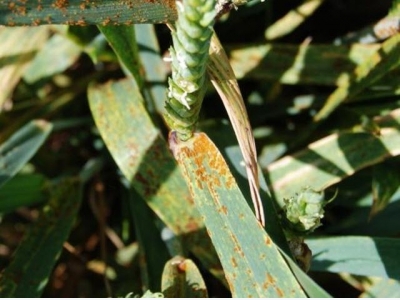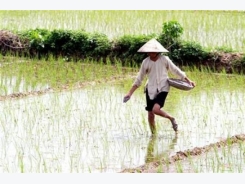New finding advances wheat stem rust understanding

Photo: Robert Park/University of Sydney - Stem rust on wheat plant.
Immune system in rust-resistant wheat plants recognizes specific fungal protein and activates resistance to fend off devastating pathogen.
For the first time ever, scientists are gaining ground in the race against wheat stem rust, a pathogen that threatens global food security because of its ability to kill wheat.
A team of researchers from the University of Sydney in Australia, the Commonwealth Scientific & Industrial Research Organization (CSIRO), Rothamsted Research, the University of Minnesota and the U.S. Department of Agriculture have discovered the first rust virulence molecule that wheat plants detect to "switch on" built-in resistance and stave off the disease
Stem rust, historically the most dangerous pathogen of wheat, is caused by the fungus Puccinia graminis f. sp. tritici (Pgt). A particularly destructive form of Pgt known as Ug99 has recently received much attention because of its spread across Africa and the Middle East, according to a University of Minnesota news release. Such geographic expansion and the emergence of other virulent strains related and not related to Ug99 have caused great concerns for wheat production. Even more alarming is the recent detection of new virulent strains in Europe, which could easily make their way to the U.S.
Findings by this group of scientists published in Science reveal how the immune system in plants resistant to this disease directly recognizes a specific fungal protein to subsequently "turn on" resistance and fend off the pathogen.
"For the first time, it will be possible to do DNA testing to identify whether a rust in a wheat crop anywhere in the world can overcome a rust resistance gene called Sr50, which is being introduced in high-yielding wheat varieties," said University of Sydney professor of sustainable agriculture Robert Park, co-leader of the research team. "This will indicate whether or not a given wheat crop needs to be sprayed with expensive fungicide quickly to protect against rust, which would otherwise devastate the crop in a matter of weeks."
This is a key finding to stay ahead of rust disease epidemics, like those that have been extremely damaging in East Africa and making a comeback in Europe, the release noted.
"It's like an ongoing arms race: We've got to keep one step ahead of this changing pathogen," Park said.
Co-corresponding author and University of Minnesota plant pathology adjunct professor Peter Dodds from CSIRO said demand for wheat in the developing world is expected to jump 60% by 2050, and in economic terms alone, the ramifications are huge.
"Now that we've identified how stem rust strains are able to overcome Sr50 resistance - by mutation of a gene we've identified called AvrSr50 -- this information can be used to help prioritize resistance genes for deployment," Dodds said.
University of Minnesota College of Food, Agricultural & Natural Resource Sciences professor Brian Steffenson and adjunct professor Yue Jin have been collecting Pgt isolates from around the world, including those causing epidemics in Africa. Plant pathology professor Melania Figueroa and graduate student Feng Li leveraged these resources to examine the genetic variability of AvrSr50 in a set of Pgt isolates with global importance.
"Close examination of the sequence of this gene in strains from diverse origin can provide important clues to understand the evolution of this pathogen and how virulence emerges," Figueroa said.
A key contribution to the study was the analysis of an Sr50 virulent strain that Jin - also a U.S. Department of Agriculture scientist -- collected from barberry, the alternate host of Pgt where the pathogen undergoes sexual reproduction. This strain contains a variation of a gene that is not recognized by Sr50, which helped confirm the identity of the gene and showed how stem rust can evolve to overcome resistance.
Using a Biosafety Level 3 containment facility, the University of Minnesota team was also able to work with the African Ug99 strain under maximum restricted conditions to prevent pathogen escape.
"It is essential we determine the propensity of Pgt strains to evolve virulence to specific resistance genes. In this case, we know that Ug99 may be primed to defeat Sr50 in the field," Figueroa said.
While this is a vital step forward in understanding how plants and this disease interact, there is much work yet to be done before scientists will have a complete understanding of these interactions. Unraveling these molecular interactions can also assist in understanding other important rust diseases, such those affecting other cereals and crops like soybeans and coffee.
"Our results so far show that the plant immune system is able to directly recognize the fungal protein, but we want to understand the whole process better -- what's going on at the protein level, at the gene level and how the fungus can escape recognition," Dodds said.
Fourth year Ph.D. student Li added, "I hope to apply this knowledge to address similar problems in food security. Wheat production is affected by two other rust pathogens. The research plan we followed in this project can guide other scientists to uncover additional virulence molecules in their systems."
This research was supported by the TwoBlades foundation, Grains Research & Development Corp. (grants US00067 and CSP00161), University of Minnesota Lieberman-Okinow and Stakman endowments, the Experimental Station USDA National Institute of Food & Agriculture Hatch Funds (project MIN-22-058) and the Biotechnology & Biological Sciences Research Council (project BB/P016855/1).
Có thể bạn quan tâm
Phần mềm

Phối trộn thức ăn chăn nuôi

Pha dung dịch thủy canh

Định mức cho tôm ăn

Phối trộn phân bón NPK

Xác định tỷ lệ tôm sống

Chuyển đổi đơn vị phân bón

Xác định công suất sục khí

Chuyển đổi đơn vị tôm

Tính diện tích nhà kính

Tính thể tích ao hồ



 Vietnam’s farming exports hit new record of US$36…
Vietnam’s farming exports hit new record of US$36…  Vietnam-grown star apples head for US
Vietnam-grown star apples head for US